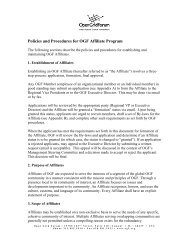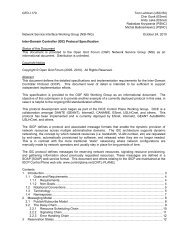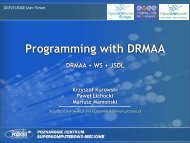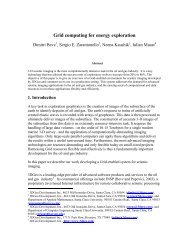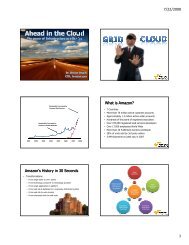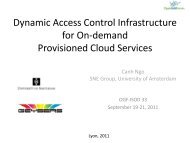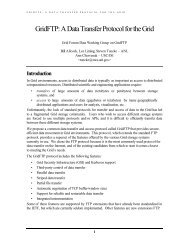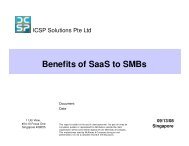A Simple XML Producer-Consumer Protocol 1 ... - Open Grid Forum
A Simple XML Producer-Consumer Protocol 1 ... - Open Grid Forum
A Simple XML Producer-Consumer Protocol 1 ... - Open Grid Forum
Create successful ePaper yourself
Turn your PDF publications into a flip-book with our unique Google optimized e-Paper software.
1. Introduction<br />
A <strong>Simple</strong> <strong>XML</strong> <strong>Producer</strong>-<strong>Consumer</strong> <strong>Protocol</strong><br />
Warren Smith, Dan Gunter, Darcy Quesnel<br />
wwsmith@nas.nasa.gov, dkgunter@lbl.gov, quesnel@mcs.anl.gov<br />
Global <strong>Grid</strong> <strong>Forum</strong> Performance Working Group<br />
This document describes a simple <strong>XML</strong>-based protocol that can be used for producers of events to<br />
communicate with consumers of events. The protocol described here is not meant to be the most<br />
efficient protocol, the most logical protocol, or the best protocol in any way. This protocol was defined<br />
quickly and its intent is to give us a reasonable protocol that we can implement relatively easily and then<br />
use to gain experience in distributed event services. This experience will help us evaluate proposals for<br />
event representations, <strong>XML</strong>-based encoding of information, and communication protocols.<br />
The next section of this document describes how we represent events in this protocol and then defines<br />
the two events that we choose to use for our initial experiments. These definitions are made by example<br />
so that they are informal and easy to understand. The following section then proceeds to define the<br />
producer-consumer protocol we have agreed upon for our initial experiments.<br />
2. Events<br />
There is an entire Performance Working Group document on event schemas. Since two of the authors of<br />
this document are authors of the event schema document, the events defined here closely relate to the<br />
events defined in this document. The difference is that the events defined here are meant to be very<br />
simple. It should be easy to write code to translate from programming language structures to the <strong>XML</strong><br />
and from the <strong>XML</strong> back to programming language structures. In this document, we use the following<br />
simplifications:<br />
• Events are not required to have explicit types that must be checked.<br />
• Element values are always strings (follows from the previous simplification).<br />
• Elements do not have any attributes, including accuracy or unit attributes.<br />
• No contexts.<br />
We assume that an event consists of a type and a set of elements where each element is a <br />
pair and the names and values are strings. Each element can be either implicitly required or optional. We<br />
say implicitly because there is not any explicit type checking being performed at this time.<br />
To further simplify things, we initially only handle 2 different types of events. The next two subsections<br />
describe these two types.<br />
2.1. CPU Load Event<br />
The CPU load event type is a simple event containing the load information returned by the Unix<br />
“uptime” command. We therefore use the event type “UptimeCPULoad” for this event to differentiate it<br />
from other means of measuring CPU load. This event must contain the following elements:<br />
• TimeStamp. The time at which the CPU load event was generated. The format of the time<br />
contained in the value of this element is a restricted version of the ASCII format proposed by the<br />
document “A Standard Timestamp for <strong>Grid</strong> Computing ” (Dan Gunter, Brian Tierney). This
standard is an extension of one of the variations of the ISO 8601 time format. To restrict the time<br />
format, we assume that all times are reported in GMT or Zulu time and that precision is not<br />
represented. An example time with milliseconds would look like: 2000-11-09T11:12:00.000Z.<br />
• Load1. The 1-minute CPU load reported by uptime.<br />
• Load5. The 5-minute CPU load reported by uptime.<br />
• Load15. The 15-minute CPU load reported by uptime.<br />
• HostName. The name of the host the load measurement is made on.<br />
Here is an example UptimeCPULoad event in our <strong>XML</strong> encoding:<br />
<br />
1.5<br />
1.6<br />
1.3<br />
foo.nas.nasa.gov<br />
2000-11-09T21:51:45Z<br />
<br />
Note that the indenting and new lines are for readability purposes only. We assume that the events will<br />
not contain any new lines or spaces around element tags when the events are transmitted.<br />
When asking for a CPU load event, the following input parameters can be specified:<br />
• Period. The number of seconds between each uptime measurement and event generation. This<br />
parameter is only used when a subscription is performed. If this parameter is specified for a<br />
query, it is ignored.<br />
An example of a description of the events a consumer wants to receive is:<br />
<br />
600<br />
<br />
2.2. Round Trip Time Event<br />
The second event we define here is a latency event with data produced by the Unix ping command. We<br />
simply call this event a “Ping” event. The event must contain the following elements:<br />
• TimeStamp. The time at which the ping was performed. The format is the same as the time<br />
stamp above.<br />
• SourceHostName. The host name or IP address of the host that is performing the ping command.<br />
• TargetHostName. The host name or IP address of the host that the source host is pinging. Note<br />
that this name or IP address can indicate 1 of several network interfaces on the target host.<br />
• RoundTripTime. The round-trip time reported by the ping command in milliseconds.<br />
Here is an example Ping event in our <strong>XML</strong> encoding:<br />
<br />
foo.nas.nasa.gov<br />
bar.lbl.gov<br />
7<br />
2000-11-09T21:53:45Z<br />
When asking for a ping event, the following input parameters can be specified:<br />
• Period. The number of seconds between each uptime measurement and event generation. This<br />
parameter is only used when a subscription is performed. If this parameter is specified for a<br />
query, it is ignored.<br />
• TargetHostName. The name or IP address of the host that will be pinged.<br />
An example of a description of which events a consumer desires is:<br />
<br />
600<br />
bar.lbl.gov<br />
<br />
3. <strong>XML</strong> <strong>Protocol</strong><br />
This section describes the <strong>XML</strong> protocol we use for communication between producers and consumers.<br />
We require that our protocol allow:<br />
• <strong>Consumer</strong>s to subscribe for events<br />
• <strong>Consumer</strong>s to unsubscribe from events<br />
• <strong>Producer</strong>s to send events to consumers<br />
• <strong>Consumer</strong>s to query for a single event<br />
We assume that:<br />
• TCP sockets are used for communication.<br />
• No authentication, authorization, or security is supported.<br />
• <strong>XML</strong> is used to represent control and data messages.<br />
• One socket between a producer and a consumer is used for both control and data messages.<br />
• Multiple subscriptions can be active over a socket.<br />
• Multiple requests can be outstanding on the same connection.<br />
Given the requirements of our protocol, we define the following messages:<br />
1. SubscribeRequest<br />
2. SubscribeReply<br />
3. UnsubscribeRequest<br />
4. UnsubscribeReply<br />
5. Event<br />
6. QueryRequest<br />
7. QueryReply<br />
Note that many of the messages are pairs of request/reply messages.<br />
3.1. General Message Format<br />
In general, each message consists of:
1. Length: the number of bytes in the message as a 32-bit integer in network byte order (C functions:<br />
htonl, ntohl)<br />
2. The <strong>XML</strong> tags that indicate the message type. For example: …<br />
or … <br />
2.1. Request messages always have a requester-unique request ID chosen by the requester. This<br />
request ID is an attribute of the message tag. For example: <br />
… .<br />
2.2. Reply messages always have a request ID. The request ID for a reply matches the request ID<br />
given by the requester for the request that is being replied to. For example, a reply to the above<br />
subscribe request would be: … .<br />
2.3. Reply messages always have a return code and may have a return message. The return code<br />
indicates if an operation was successful (0) or a failure (1). These return codes may be expanded<br />
later to contain different non-zero error codes. The return message is a text message that<br />
contains detailed user-readable information about the status of a request.<br />
3. The message-specific data inside the <strong>XML</strong> tags that identify the message. For example:<br />
… <br />
<br />
3.2. Subscribing for Events<br />
When a consumer wants to receive a stream of events from a producer, it subscribes for events. For now<br />
we are assuming that after a subscription, a producer pushes events to the consumer that has subscribed<br />
for them. This subscription takes the form of a SubscribeRequest message from the consumer to the<br />
producer, followed by a SubscribeReply message from the producer to the consumer.<br />
3.2.1. SubscribeRequest Message<br />
The subscribe request message consists of:<br />
• Event type (required).<br />
• Any input parameters needed to generate events (optional).<br />
• Request ID so that a reply can be matched with a request.<br />
Here are two examples of SubscribeRequest messages:<br />
<br />
<br />
600<br />
<br />
<br />
<br />
<br />
300<br />
bar.lbl.gov<br />
<br />
<br />
Note: In the future, we will probably want an event filter. After a producer generates an event, a filter is<br />
used to determine if the event should be sent to a consumer. For example, a filter may indicate that an
event should be sent only if the load is greater than 5.0. The filter is a Boolean expression of event<br />
element names and constants that is applied to an event. We think the filter specification should go<br />
inside the PingParameters.<br />
3.2.2. SubscribeReply Message<br />
The subscribe reply message consists of:<br />
• ReturnCode (required). 0 means success, 1 means failure. More non-zero return codes to<br />
represent more detailed failures may be added in the future.<br />
• ReturnMessage (optional). Text giving further information about the successful or unsuccessful<br />
subscribe.<br />
• Request ID of the request that this message is in reply to.<br />
• An optional producer-unique SubscriptionID that identifies the subscription that was successfully<br />
made by the consumer (if one was). The subscription ID should be present if the subscription<br />
was successful and should not be present if the subscription was not successful. The subscription<br />
ID is used so that a consumer can easily route an event to the handler for events from that<br />
subscription.<br />
Two examples of SubscribeReply messages are:<br />
<br />
1<br />
The period specified is too small.<br />
<br />
<br />
0<br />
1234<br />
<br />
3.3. Unsubscribing from Events<br />
When a consumer wishes to stop receiving a stream of events from a producer, it unsubscribes from<br />
those events. This unsubscription is accomplished by the consumer sending an UnsubscribeRequest<br />
message to the producer and the producer sending an UnsubscribeReply message back to the consumer<br />
in response to the request.<br />
3.3.1. UnsubscribeRequest Message<br />
The unsubscribe request message consists of:<br />
• The RequestID of the request that this message is in reply to.<br />
• The SubscriptionID that identifies the subscription to be unsubscribed from.<br />
An example of an UnsubscribeRequest message is:<br />
<br />
1234<br />
3.3.2. UnsubscribeReply Message<br />
The unsubscribe reply message consists of:<br />
• ReturnCode (required). 0 means success, 1 means failure. More non-zero return codes to<br />
represent more detailed failures may be added in the future.<br />
• ReturnMessage (optional). Text giving further information about the successful or unsuccessful<br />
subscribe.<br />
• Request ID of the request that this message is in reply to.<br />
Example of an UnsubscribeReply message are:<br />
<br />
0<br />
<br />
<br />
1<br />
Unknown subscription ID.<br />
<br />
3.4. Event Message<br />
An event message is sent from the producer to the consumer after a consumer has subscribed for events.<br />
An event message consists of:<br />
• A subscription ID to identify which subscription the event is for<br />
• The event data in the format described in Section 2.<br />
Example Event messages are:<br />
<br />
<br />
1.5<br />
1.6<br />
1.3<br />
2000-11-09T21:51:45Z<br />
<br />
<br />
<br />
<br />
foo.nas.nasa.gov<br />
bar.lbl.gov<br />
7<br />
2000-11-09T21:53:45Z <br />
<br />
<br />
3.5. Querying for an Event<br />
We believe there will be many cases when a consumer wants to ask for just 1 event from a producer.<br />
Instead of having a consumer subscribe, receive 1 event, and then unsubscribe, we allow a consumer to
query a producer for an event. This query consists of a QueryRequest message that a consumer sends to<br />
the producer and a QueryReply message that the producer sends to the consumer in response to the<br />
QueryRequest message.<br />
3.5.1. QueryRequest Message<br />
The query request message is very similar to the subscribe request message and consists of:<br />
• Event type (required).<br />
• Any input parameters needed to generate events (optional).<br />
• Request ID so that a reply can be matched with a request.<br />
Here are two examples of QueryRequest messages:<br />
<br />
<br />
<br />
<br />
<br />
<br />
bar.lbl.gov<br />
<br />
<br />
3.5.2. QueryReply Message<br />
The QueryReply messages are similar to the event messages and consist of:<br />
• A request ID to identify which QueryRequest this reply is for<br />
• The event data in the format described in Section 2.<br />
Example QueryReply messages are:<br />
<br />
<br />
1.5<br />
1.6<br />
1.3<br />
2000-11-09T21:51:45Z<br />
<br />
<br />
<br />
<br />
foo.nas.nasa.gov<br />
bar.lbl.gov<br />
7<br />
2000-11-09T21:53:45Z <br />
<br />
4. Summary<br />
This document describes a simple <strong>XML</strong> publish-subscribe protocol for performance events. The<br />
protocol described here is not meant to be the most efficient protocol, the most logical protocol, or the<br />
best protocol in any way. However, it provides a foundation of practical experience for evaluating<br />
alternate protocol implementations, including higher-level solutions such as <strong>XML</strong>-RPC<br />
(http://www.xml-rpc.com) and SOAP (http://www.develop.com/soap).<br />
If you have comments on this paper, you can contact the authors or the <strong>Grid</strong> <strong>Forum</strong> Performance<br />
Working Group at perf-wg@gridforum.org. The <strong>Grid</strong> <strong>Forum</strong> is an open community; more information<br />
on current activities and how to join is available at the main web site (http://www.gridforum.org) and the<br />
Performance Working Group site (http://www-didc.lbl.gov/<strong>Grid</strong>Perf/).<br />
5. Acknowledgements<br />
Input from many people went into this document, including many of the attendees of the <strong>Grid</strong> <strong>Forum</strong><br />
meetings. The LBNL portion of this work is supported by the U.S. Department of Energy, Office of<br />
Science, Office of Computational and Technology Research, Mathematical, Information, and<br />
Computational Sciences Division, under contract DE-AC03-76SF00098 with the University of<br />
California.




